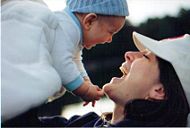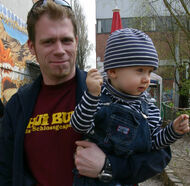| (One intermediate revision by one other user not shown) | |||
| Line 32: | Line 32: | ||
==See also== |
==See also== |
||
| + | *[[Environmental enrichment (neural)]] |
||
*[[Failure to thrive]] |
*[[Failure to thrive]] |
||
*[[Feral child]] |
*[[Feral child]] |
||
| Line 71: | Line 72: | ||
[[Category:Living people|Rutter, Michael]] |
[[Category:Living people|Rutter, Michael]] |
||
[[Category:Child psychiatrists]] |
[[Category:Child psychiatrists]] |
||
| − | [[Category:Attachment |
+ | [[Category:Attachment]] |
[[Category:Psychoanalysis]] |
[[Category:Psychoanalysis]] |
||
[[Category:Psychological theories]] |
[[Category:Psychological theories]] |
||
Latest revision as of 08:37, 17 December 2011
Assessment |
Biopsychology |
Comparative |
Cognitive |
Developmental |
Language |
Individual differences |
Personality |
Philosophy |
Social |
Methods |
Statistics |
Clinical |
Educational |
Industrial |
Professional items |
World psychology |
Animals · Animal ethology · Comparative psychology · Animal models · Outline · Index
It was Dr John Bowlby in Maternal Care and Mental Health (1951)[1] who argued that infants form a special relationship with their mother, which is qualitatively different from the relationship which they form with any other

Mother and child
kind of person. Bowlby described this as the process of 'monotropy'. By a mechanism which he saw as very similar to imprinting, Bowlby considered that the young infant developed a firm attachment to its mother within the first six months of life, and that if this attachment or bond was then broken the infant would suffer serious consequences. "Even good mothering is almost useless if delayed after the age of 2 and a half". From the beginning Bowlby's work assumed a political dimension as his arguments were seized by one group or another to show that either fathers should provide for their

Father and child
family or that mothers should stay at home to look after their children, so much so that the World Health Organisation felt obliged to publish a rebuttal called 'Deprivation of maternal care. A reassessment of its effects' (1962).[2] Professor Sir Michael Rutter in Maternal Deprivation Reassessed (1972)[3], which New Society described as a, 'classic in the field of child care', showed that children are not invariably so damaged and that, in any event, other people, including their fathers, are also very important to children.
According to Schaffer in 'Social Development' (2000)[4] it seems likely that social convention explains whatever differences are observed amongst parents and that when fathers do assume the principal responsibility for their children such differences disappear. This is borne out by the study by Field (1978)[5] of standardized parent infant interaction. The notion that fathers are necessarily less competent with or less responsive to their children receives no support from physiological measures (Berman, 1980)[6] or research evidence (Parke, 1981)[7].
It was as a result of this body of criticism that Bowlby went on to diffuse the concept of 'Maternal Deprivation' into the attachment theory and it is now generally accepted that either or both parents may be the child's 'primary carer'.
Significant differences between Maternal Deprivation and the Attachment Theory
Adapted from 'Clinical Implications of Attachment Concepts: Retrospect and Prospect' (Journal of Child Psychology and Psychiatry Volume. 36 No 4, p551, 1995) by Professor Sir Michael Rutter.
(1) The abandonment of the notion of monotropy. Bowlby's early writings were widely understood to mean that there was a biological need to develop a selective attachment with just one person.
(2) It came to be appreciated that social development was affected by later as well as earlier relationships.
(3) Early accounts emphasized the need for selective attachments to develop during a relatively brief sensitivity period with the implication that even good parenting that is provided after that watershed is too late.
(4) Bowlby drew parallels between the development of attachments and imprinting. It became apparent that there were more differences than similarities and this comparison was dropped later on and is no longer seen as helpful by most writers on attachment.
Maternal deprivation studies in animals
This syndrome has been demonstrated in a number of species in addition to humans, including monkeys and mice.
- Main article: Maternal deprivation studies in animals
Neurological and physiological consequences of maternal deprivation
See also
References & Bibliography
- ↑ Bowlby, J (1951) Maternal Care and Mental Health, World Health Organisation WHO
- ↑ Ainsworth, M (1962 ) Deprivation of maternal care. A reassessment of its effects, World Health Organisation WHO
- ↑ Rutter (1981) Maternal Deprivation Reassessed, Second edition, Harmondsworth, Penguin.
- ↑ Schaffer (2000) Social Development, Oxford, Blackwell
- ↑ Field, T (1978) Interaction behaviours of primary versus secondary caretaker fathers, Developmental Psychology, 14, 183-184
- ↑ Berman, P W (1980) Are women more responsive than men to the young? A review of developmental and situational variables, Psychological Bulletin, 88, 668-695.
- ↑ Parke (1981) Fathering, Collins; Cambridge, MA Havard University Press
Key texts
Books
- Rutter, M. (1981) Maternal Deprivation Reassessed, 2nd edn, Harmondsworth: Penguin
- Patton, R.G. and Gardner, L.I. (1963) Growth Failure in Maternal Deprivation, London: C.C. Thomas.
Papers
- Rutter, M. (1979) Maternal deprivation 1972-1978: new findings, new concepts, new approaches, Child Development 50: 283-305.
Additional material
Books
Papers
External links
- International Attachment Conference 2007
- Relationship Advice: How Understanding Adult Attachment Can Help
- Attachment theory in the classroom
- Attachment Questionnaire
- Attachment Diagnostics (German)
- Details of authors, publications, measures and books on attachment psychology
- A support forum for adults with attachment disorder or attachment related issues.. welcome!
- Rene Spitz's movie "Psychogenic Disease in Infancy" (1957) showing examples of children with insecure attachments
Maternal deprivation occurs where infants are deprived of maternal contact or care, handling or nurturing. This can lead to maternal deprivation syndrome, a group of symptoms including stunted physical growth and/or retarded emotional development.